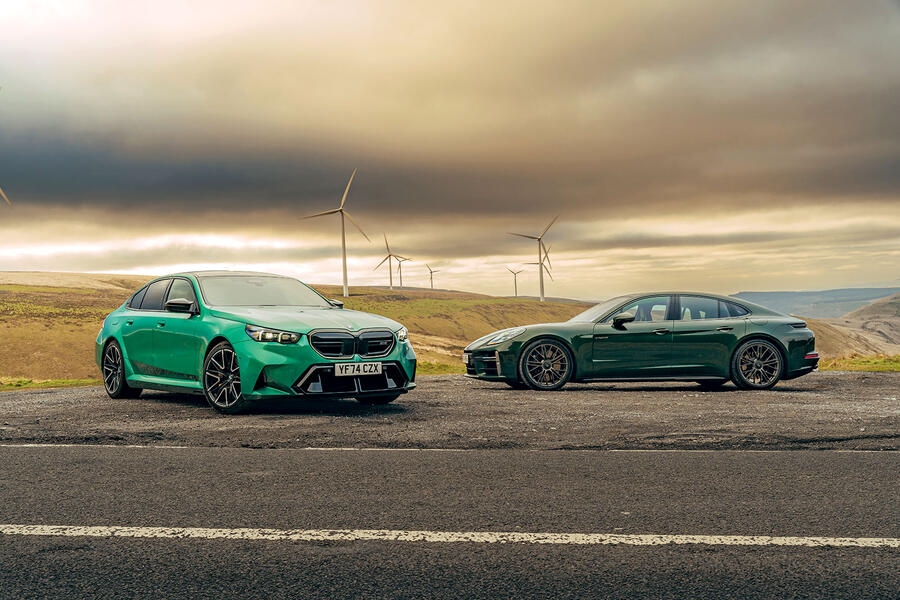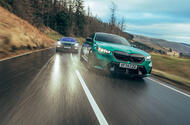M5 weighs in with 718bhp/738lb ft. Panamera packs 671bhp/686 lb ft
The new BMW M5 is a 2.4-tonne, big-hitting PHEV, but has it met its match with the Porsche Panamera?
The seventh-generation BMW M5 super-saloon is, right now, lurking ominously in my rear-view mirror as the winter dawn breaks slowly on the westbound M4.
That car has much to prove and today it should have some great roads to prove it on, and a fair, modern rival against which to compete – rather than being weighed down by many decades of wonderful, celebrated and broadly irrelevant performance car heritage.
On which topic, I wonder if the M division management might now consider it a mistake to have rolled out so many old-generation M5 ‘heritage vehicles’ on the international press launch of this new model a couple of months ago.
Naivety? Misplaced confidence? Hubris, even? Reactions to this car from those at the event have been a little varied.
But few testers argued that it felt anything other than big, heavy and necessarily complex – a little uncommunicative and lacking, perhaps, in simple, accessible fun factor.
Frankly, next to a 30-year-old, 1700kg E34-generation M5, which modern performance saloon wouldn’t?
But will it today? The things that have made this G90-generation M5 weigh 2435kg in four-door form are after all entirely reasonable, understandable – even ineluctable – things.
Howl at the moon if you like and blame BMW M for somehow failing to resist the legislative forces that have already led many of its rivals to electrify and will continue to do so for others.
But then ask yourself this: would you rather not have a new M5 at all? What about one with a four-cylinder turbo engine? Or an electric rear axle that runs out of puff when the battery runs dry?
What about an all-electric M5? Or one without electrification entirely but made in tiny numbers and priced like some diamond-encrusted unicorn?
Those were probably the options and, regrettably perhaps, ‘more of the same’ almost certainly wasn’t among them.
BMW M, it seems to me, has done its best to keep this car commercially viable in 2025, in the mechanical format that best suits it and best represents how we have come to know it.
And here’s the thing. In the end, it has produced a car that is, in fact, only 75kg heavier than a Porsche Panamera Turbo E-Hybrid, the key rival with which we’re comparing it today.
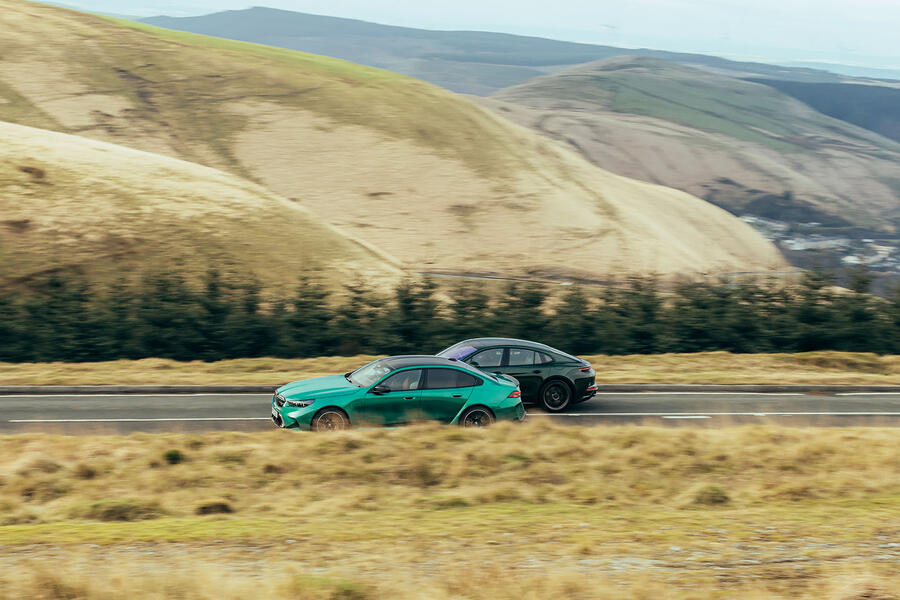
Only 75kg. Weight is weight; it’s evil, I get it. But, in the cold light of a wintry mountain day, 75kg might not prove to be a sum worth banging your desk and rolling your eyes about. Not in 2025, in a performance car at the bigger end of the market.
We’ll see. For now, as the crepuscular gloom lifts, all I can see in the Porsche’s rear-view mirror is the BMW’s ridiculous ‘Iconic Glow’ kidney grille hovering there in the outside lane (which, I will admit, certainly is a few kilos that it didn’t need).
It’s a little like being followed into the Welsh mountains by the angelic, reincarnated spirit of 1990s TV sitcom great – and master of the absurd – Gordon Brittas, in his most flared of nostril aero settings.
So can either of our 2.4-tonne super-saloons escape a sense of the absurd on the narrow, bumpy, beautiful A-roads of Rhondda?
Seconds out…
BMW did its usual belt-and-braces job of the preamble to the launch of this M5. As you may have read, there were separate prototype drives on road and track last year – and in both saloon and returning Touring bodystyles – before we finally drove the finished car in November.
So you’re unlikely to need a very detailed technical exposition of how much ‘electrification’ this car uses. We can simply note that the car still has a twin-turbo V8 up front and retains a mechanical, electronically controlled, switchable four-wheel drive system downstream of an eight-speed automatic gearbox.
It sticks to steel coil suspension springs (although they’re progressively rated ones) and conventional anti-roll bars but it adopts an electric steering rack and four-wheel ‘Integral Active’ steering (the old F90-gen car didn’t have this).
And its hybrid system, shared with the humbler 530e PHEV, consists of a 194bhp electric motor integrated upstream of the gearbox and drawing power from an underfloor battery pack of just over 22kWh of total installed capacity.
How the Panamera compares leads you to some key realisations. It’s less powerful, slightly, and yet quicker-accelerating, according to the spec sheet (with the even quicker Turbo S there in the showroom if you feel you need it).
And, yes, it’s lighter – despite having a bigger hybrid drive battery than its opponent, four-wheel steering as standard (just like the BMW), air suspension also as standard (unlike the BMW, a set-up that typically adds weight compared with steel coils) and an electric drive motor of very similar power to the M5’s configured and located in much the same way.
The Panamera is the slightly lower, shorter car of the two but it’s also the older car. So why wouldn’t BMW have been able to beat the Porsche on kerb weight? The answer, as M division engineers will admit when pressed, isn’t to do with the M5’s hybrid system at all.
Rather, it’s the chassis bracing needed to shore up a platform that’s now been chopped about and modified so as to accommodate the all-electric i5, the long-wheelbase G68-gen 5 Series for China, and other variants.
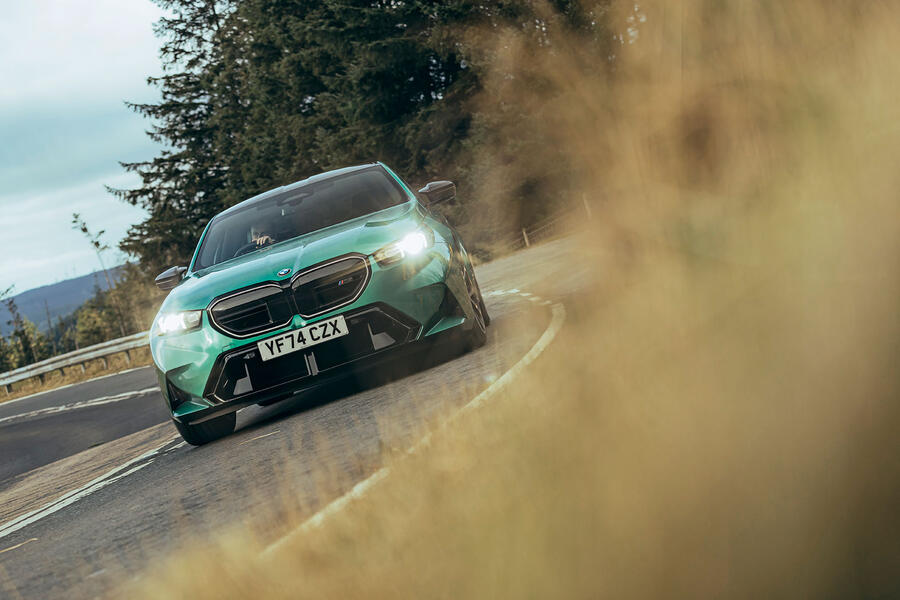
As M division technical boss Dirk Hacker confirmed when I met him to drive a prototype last summer, more of this car’s weight gain is actually from structural reinforcements than from electric motors and batteries.
Although at least some of it must be from LED lighting features. Crikey, there are a lot of those and they’re not subtle.
The M5 has what BMW calls its ‘interaction bar’ – a strip of fairly unlovely plastic running across the breadth of the fascia, which lights up in a colour determined by your selected driving mode.
It adopts special illumination skits, for instance, when you engage your hazard warning lights. At one moment, it’s bile green; and then neon red, with BMW M tricolour colouring at its middle, when you move into Sport driving mode.
It wants your attention, basically – a lot. And that’s in stark contrast to the ambient lighting in the Panamera, which is gentle and inset into folds in the fascia so that it shines soft, reflected light into the cabin, as if into some expensive penthouse kitchen.
Which looks the more convincingly expensive? It depends on taste, a bit, but if you have much of that, I’d like to think you’d prefer the Porsche.
The BMW’s cabin is the more spacious of the two, though – not least because the Panamera has the lower hip point and more sloping roofline, but also because the M5 is clearly the wider car.
If this were a test of extra-practical and versatile fast wagons, namely an M5 Touring and a Panamera Sport Turismo, I suspect that the BMW’s bigger back seats and boot would give it a decisive edge over the Porsche for usability.
It’s not, though, and that’s because you can’t get a Panamera Sport Turismo any more. Porsche axed it with the car’s 2024 facelift.
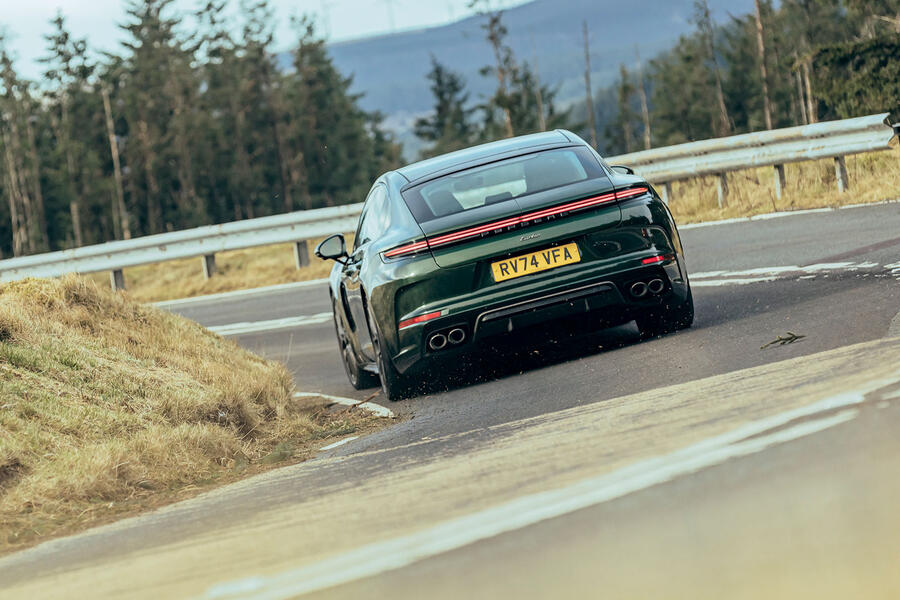
And saloon versus ‘saloon’ (the Panamera is actually more like a big hatchback), the Porsche’s more accessible boot might well more than make up for in cargo practicality what it gives up to the BMW in terms of second-row space. Here, maybe bigger doesn’t necessarily also mean more usable.
The Panamera certainly has the more convincing, consistently expensive-feeling, luxury-grade interior – and the lower-couched, though slightly smaller, driver’s seat. Its operating concept is less weighed down by the onslaught of mode selection than the M5’s.
It offers simpler, easier routes to switch off the ADAS features that are most likely to irk. Settling into the Porsche’s driver’s seat, you know instinctively what its priorities are and you needn’t take long tuning the car to suit your own mood and journey.
In the BMW – with a smorgasbord of options to puzzle through (M mode, powertrain mode, damping mode, steering mode, gearbox setting, driveline torque distribution mode, stability control level… the list goes on) – you could spend days experimenting, just as I did, and still feel little the wiser.
The final round
These winding, steep, bumpy and variously narrow mountain roads are a tough test of a big, fast saloon car.
But they waste no time at all in revealing what ‘good’ feels like when it comes to keeping one within the borders of its lane and primed for the moment when the vista opens in front of you, and you can feel – for a few, eye-opening seconds, at least – what 700 electrically assisted horsepower feels like.
The horses aren’t really what you notice, though. Rather, the influence of these cars’ electric motors is to give each of them Herculean, cliff-edge torque.
So – much as you might indulge yourself with them anyway, just because – three downshifts and a blast to the redline just aren’t required to make these cars explode forwards. One casual flick of your left index finger and a deep squeeze of your right foot will do it.
What the M5 has and the Panamera lacks is a dedicated two-speed gearbox for the electric motor, multiplying the torque that it puts into the mechanical driveline.
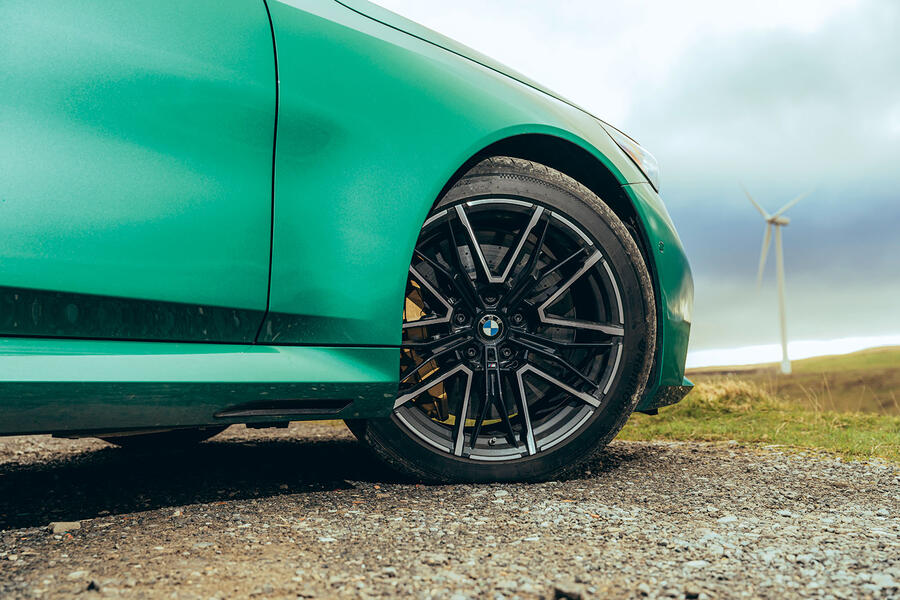
It certainly feels marginally the more brutish car when picking up on a hair trigger from bumbling-level revs, but only in as much as sprinter Maurice Greene was usually a slightly faster starter than Linford Christie right on the official’s gun.
Both cars are ‘big units’ and both will take off at such a rate and with such little need for preparation that it makes rather a mockery of the inclusion of their high-response ‘nuclear buttons’.
In the M5 you enter ‘boost’ mode through a long pull on the downshift paddle, and in the Panamera you press the central button on the wheel-mounted driving mode selector – in both cases, to get the car’s combustion engine, gearbox, electric motor and power electronics all set to ‘DEFCON 1’.
At that point, hitting the accelerator feels a little like a crime against topography.
So, yes, both cars are wickedly, monstrously fast. And neither, importantly, ever seems to get to a point where its battery is depleted, its electric motor neutered, and its V8 engine left with excess ballast and no back-up.
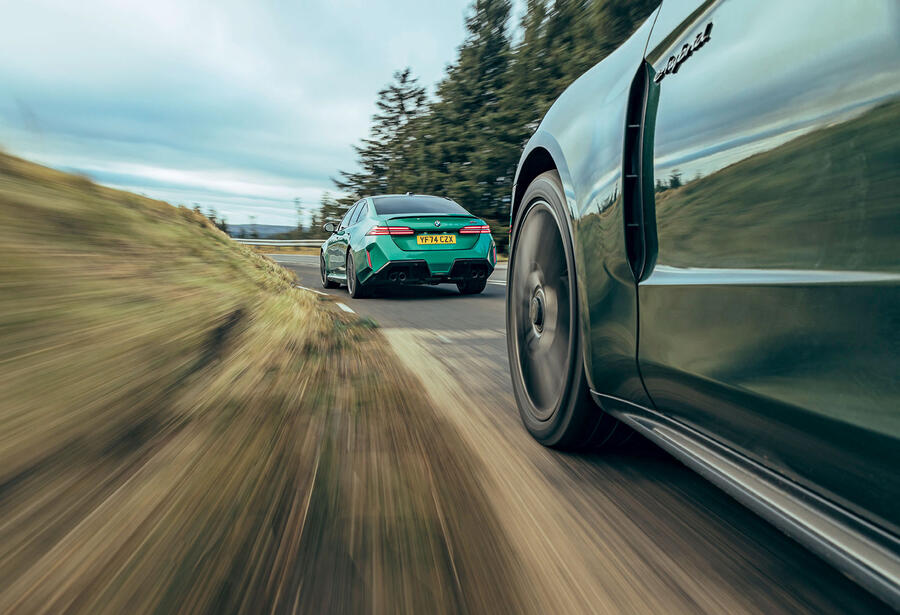
They both have performance so indefatigable, responsive and outright potent as to leave the vast majority of it untapped 95% of the time, which itself perhaps doesn’t make either of them as exciting to drive as they might be if they were – whisper it – actually a bit slower.
But the M5 and Panamera aren’t so hard to separate for their ride and handling. It’s impossible to say if the BMW’s weight really is the decisive factor here, but to me its size is at least as important – and likewise, its particular tuning.
The M5 just feels rather wantonly burly and big – wide and substantial in its footprint, firm and steadfastly level in its bodily responses, quite heavy and sometimes a little recalcitrant and leaden in its control feedback. It’s just a bit of a beast.
Against all of that, the agility and balance it can generate comes as all the more of a surprise when it does materialise – and it arrives all right. The M5 can grip and rotate when it wants to.
But it’s all thanks to some quite unyielding anti-roll bar settings, which rob the car of fluency on uneven surfaces and can make it slightly reactive and sensitive to camber.
The Panamera simply has the knack of marshalling and managing its weight more nonchalantly. Perhaps its active anti-roll bars help it here, or the greater range of adjustability of its air springs, or the greater experience Porsche has with four-wheel steering.
But the Panamera just gets into, through and out of corners with so much less effort and it can be placed with so much more intuitive confidence. It finds its line sooner, stays on it more dependably, thanks to more pliant ride rates, and feels even more naturally agile than the BMW but supple and fluent with it.
If I’m honest, I expected this contest to be won by the least worst electrified super-saloon – the one whose size and bulk felt least exposed by the bumps, grates, kerbs, narrowness and cambers of some of Wales’s most unsympathetic stretches of mountain blacktop.
But while the BMW has struggled and floundered here and there, making something of a straitjacket out of its 700bhp as often as making hay with it, the Porsche has proven surprisingly dynamically versatile.
It has shown that when it comes to making really big driver’s cars, the M division’s problem might not be mass per se – but just how cleverly it can make the kilos melt away when called to.
